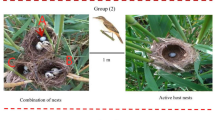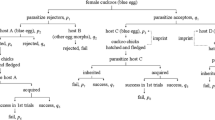Abstract
Blackcaps Sylvia atricapilla reject artificial cuckoo eggs, and their eggs vary little in appearance within clutches, whereas among clutches eggs vary considerably. Low variation within clutches facilitates discrimination of parasitic eggs, whereas high variation among clutches makes it harder for the cuckoo to mimic the eggs of a certain host species. These traits have most probably evolved as counteradaptations against brood parasitism by the common cuckoo Cuculus canorus, even though blackcaps are not regularly parasitised today. In this study, we investigated how fine-tuned the rejection of parasitic eggs is in this species by introducing three types of eggs into their nests: a real non-mimetic egg the approximate size of a cuckoo egg, an artificial mimetic egg the size of a cuckoo egg and a real conspecific egg. As the rejection frequency of both mimetic and non-mimetic artificial cuckoo eggs has been shown to be high in previous studies, the variation in rejection behaviour between individuals is low, indicating that most individuals within the population are able to reject parasitic eggs. Thus, we predict that (1) the intraclutch variation in egg appearance should be generally low in all individuals, and that (2) regarding conspecific eggs, rejection decisions should be highly dependent on the degree of mimicry between parasitic and host eggs. We found support for these predictions, which indicates that due to their highly sophisticated countermeasures against brood parasitism, blackcaps can probably be regarded as current winners of the arms race with the common cuckoo. Furthermore, the high and consistent rejection frequency of cuckoo eggs found throughout Europe for this species supports the spatial habitat structure hypothesis, which claims that woodland-nesting species breeding near trees, like blackcaps, presumably experienced a high level of parasitism throughout their range in the past and, therefore, their rejection behaviour, once evolved, spread rapidly to all populations.
Similar content being viewed by others
References
Berthold P, Solenen T (1997) Sylvia atricapilla—Blackcap. In: Hagemeijer WJM, Blair MJ (eds) The EBCC atlas of european breeding birds: their distribution and abundance. T & AD Poyser, London, pp 600–601
Braa AT, Moksnes A, Røskaft E (1992) Adaptations of Bramblings and Chaffinches towards parasitism by the Common Cuckoo. Anim Behav 43:67–78
Briskie JV, Sealy SG, Hobson, KA (1992) Behavioral defences against avian brood parasitism in sympatric and allopatric host populations. Evolution 46:334–340
Čapek W (1910) Einiges über die Fortpflanzungsgeschichte des Kuckucks aus Mähren. Berichte 5 Int Ornithol Kongreß Berlin, pp 579–582
Davies NB (2000) Cuckoos, cowbirds and other cheats. T & AD Poyser, London
Davies NB, Brooke M de L (1989) An experimental study of co-evolution between the Cuckoo, Cuculus canorus, and its hosts. I. Host egg discrimination. J Anim Ecol 58:207–224
Davies NB, Brooke M de L, Kacelnik A (1996) Recognition errors and probability of parasitism determine whether Reed Warblers should accept or reject mimetic Cuckoo eggs. Proc R Soc Lond B 263:925–931
Dawkins R, Krebs JR (1979) Arms races between and within species. Proc R Soc Lond B 205:489–511
Flajšhans V (1928) Klaret a jeho družina—texty glossované. Česká Akademie, Praha
Géroudet P (1950) Quels sont les hôtes du Coucou? Nos Oiseaux 1950:201–208
Gibbs HL, Sorenson MD, Marchetti K, Brooke M de L, Davies NB, Nakamura H (2000) Genetic evidence for female host-specific races of the Common Cuckoo. Nature 407:183–186
Glue D, Murray E (1984) Cuckoo hosts in Britain, vol 134. BTO News, p 5
Honza M, Moksnes A, Røskaft E, Stokke BG (2001) How are different common cuckoo Cuculus canorus egg morphs maintained? An evaluation of different hypotheses. Ardea 89:341–352
Lessells CM, Boag PT (1987) Unrepeatable repeatabilities: a common mistake. Auk 104:116–121
Lindholm AK, Thomas RJ (2000) Differences between populations of Reed Warblers in defences against brood parasitism. Behaviour 137:25–42
Lotem A, Nakamura H, Zahavi A (1992) Rejection of Cuckoo eggs in relation to host age: a possible evolutionary equilibrium. Behav Ecol 3:128–132
Lotem A, Nakamura H, Zahavi A (1995) Constraints on egg discrimination and Cuckoo—host co-evolution. Anim Behav 49:1185–1209
Lucanus FR von (1921) Zur Frage der Mimikry der Kuckuckseier. J Ornithol 69:239–258
Makatsch W (1937) Der Brutparasitismus der Kuckucksvögel. Quelle & Meyer, Leipzig
Makatsch W (1955) Der Brutparasitismus in der Vogelwelt. Neumann, Radebeul
Malchevsky AS (1958) O biologicheskih rasah obyknovennoy kukushki (Cuculus canorus L.) na territorii evropeyskoy chasti SSSR. Zool Zhurn 37:87–95
Malchevsky AS (1987) Kukushka i ee vospitateli. Izdatel’stvo Leningradskogo Universiteta, Leningrad
Marchetti K (2000) Egg rejection in a passerine bird: size does matter. Anim Behav 59:877–883
McLean IG, Maloney RF (1998) Brood parasitism, recognition, and response. In: Rothstein SI, Robinson SK (eds) Parasitic birds and their hosts: studies in coevolution. Oxford University Press, Oxford, pp 255–269
Moksnes A (1992) Egg recognition in Chaffinches and Bramblings. Anim Behav 44:993–995
Moksnes A, Røskaft E (1989) Adaptations of meadow pipits to parasitism by the common cuckoo. Behav Ecol Sociobiol 24:25–30
Moksnes A, Røskaft E (1992) Responses of some rare Cuckoo hosts to mimetic model Cuckoo eggs and to foreign conspecific eggs. Ornis Scand 23:17–23
Moksnes A, Røskaft E (1995) Egg-morphs and host preference in the Common Cuckoo (Cuculus canorus): an analysis of Cuckoo and host eggs from European museum collections. J Zool (Lond) 236:625–648
Moksnes A, Røskaft E, Braa AT, Korsnes L, Lampe HM, Pedersen HC (1990) Behavioural responses of potential hosts towards artificial Cuckoo eggs and dummies. Behaviour 116:64–89
Moksnes A, Røskaft E, Mørkved Solli M (1994) Documenting puncture ejection of parasitic eggs by Chaffinches Fringilla coelebs and Blackcaps Sylvia atricapilla. Fauna Norv Ser C 17:115–118
Moltoni E (1951) Le specie di uccelli nel cui nido vengono deposte in Italia le uova dal Cuculo. Riv Ital Ornitol 21:75–78
Moskát C, Szentpetéri J, Bárta Z (2002) Adaptations by great reed warblers brood parasitism: a comparison of populations in sympatry and allopatry with the Common Cuckoo. Behaviour 139:1313–1329
Øien IJ, Moksnes A, Røskaft E (1995) Evolution of variation in egg color and marking pattern in European passerines: adaptations in a coevolutionary arms race with the Cuckoo, Cuculus canorus. Behav Ecol 6:166–174
Øien IJ, Moksnes A, Røskaft E, Edvardsen E, Honza M, Kleven O, Rudolfsen G (1999) Conditional host responses to Cuckoo Cuculus canorus parasitism. In: Adams NJ, Slowtow RH (eds) Proc 22 Int Ornithol Congr , vol 22, pp 3125–3145
Procházka P, Honza M (2003) Do Common Whitethroats discriminate against alien eggs? J Ornithol 144:354–363
Røskaft E, Moksnes A (1998) Coevolution between brood parasites and their hosts. In: Rothstein SI, Robinson SK (eds) Parasitic birds and their hosts: studies in coevolution. Oxford University Press, Oxford, pp 236–254
Røskaft E, Moksnes A, Stokke BG, Bičík V, Moskát C (2002a) Aggression to dummy cuckoos by potential European cuckoo hosts. Behaviour 139:613–628
Røskaft E, Moksnes A, Stokke BG, Moskát C, Honza M (2002b) The spatial habitat structure of host populations explains the pattern of rejection behavior in hosts and parasitic adaptations in cuckoos. Behav Ecol 13:163–168
Rodríguez-Gironés MA, Lotem A (1999) How to detect a Cuckoo egg: a signal-detection theory model for recognition and learning. Am Nat 153:633–648
Rothstein SI (1990) A model system for coevolution: avian brood parasitism. Annu Rev Ecol Syst 21:481–508
Rothstein SI (2001) Relic behaviours, coevolution and the retention versus loss of host defences after episodes of avian brood parasitism. Anim Behav 61:95–107
Soler JJ, Møller AP (1996) A comparative analysis of the evolution of variation in appearance of eggs of European passerines in relation to brood parasitism. Behav Ecol 7:89–94
Soler M, Soler JJ, Martínez JG, Pérez-Contreras T, Møller AP (1998) Micro-evolutionary change and population dynamics of a brood parasite and its primary host: the intermittent arms race hypothesis. Oecologia 117:381–390
Soler JJ, Martínez JG, Soler M, Møller AP (1999) Genetic and geographic variation in rejection behavior of cuckoo eggs by European magpie populations: an experimental test of rejecter-gene flow. Evolution 53:947–956
Soler M, Martín-Vivaldi M, Pérez-Contreras T (2002) Identification of the sex responsible for recognition and the method of ejection of parasitic eggs in some potential Common Cuckoo hosts. Ethology 108:1093–1101
Stokke BG, Moksnes A, Røskaft E, Rudolfsen G, Honza M (1999) Rejection of artificial Cuckoo (Cuculus canorus) eggs in relation to variation in egg appearance among Reed Warblers (Acrocephalus scirpaceus). Proc R Soc Lond B 266:1483–1488
Stokke, BG, Moksnes A, Røskaft E (2002a) Obligate brood parasites as selective agents for evolution of egg appearance in passerine birds. Evolution 56:199–205
Stokke BG, Honza M, Moksnes A, Røskaft E, Rudolfsen G (2002b) Costs associated with recognition and rejection of parasitic eggs in two European passerines. Behaviour 139:629–644
Stokke BG, Rudolfsen G, Moksnes A, Røskaft E (2004) Rejection of conspecific eggs in chaffinches: the effect of age and clutch characteristics. Ethology (in press)
Yom-Tov Y (2001) An updated list and some comments on the occurrence of intraspecific nest parasitism in birds. Ibis 143:133–143
Acknowledgements
We thank Milica Požgayová and Tomáš Grim for their assistance in the field. Professor Jana Nechutová kindly provided a copy of the Latin text of Master Claretus’ poem on the cuckoo. Two anonymous referees significantly improved a previous version of the manuscript. This study was supported by grants from the Grant Agency of the Czech Republic no. 206/00/P046, the Grant Agency of the Academy of Sciences no. A6093203 awarded to M.H., the Grant Agency of Charles University no. 124/2001-B-BIO awarded to P.P. and the Research Council of Norway, grant no. 125805/410 to B.G.S.
Author information
Authors and Affiliations
Corresponding author
About this article
Cite this article
Honza, M., Procházka, P., Stokke, B.G. et al. Are blackcaps current winners in the evolutionary struggle against the common cuckoo?. J Ethol 22, 175–180 (2004). https://doi.org/10.1007/s10164-004-0119-1
Received:
Accepted:
Published:
Issue Date:
DOI: https://doi.org/10.1007/s10164-004-0119-1




